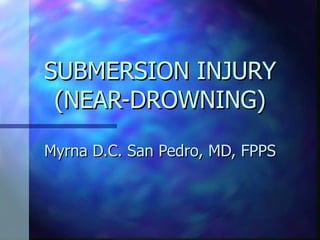
Submersion Injury (Near-Drowning) Symptoms, Causes, Treatments
- 1. SUBMERSION INJURY (NEAR-DROWNING) Myrna D.C. San Pedro, MD, FPPS
- 2. WHO Facts on Drowning Unintentional Injuries in Children <15 years (WHO, 2001)
- 15. Pathophysiology Dry drowning, 10-20%, secondary to Airway Hypoxemia Multi-organ effects Wet drowning, 80-90%, secondary to Aspiration Submersion Incident (Critical period probably 3-5 min) Involuntary Gasping (Aspiration of water into the hypopharynx Laryngospasm (Parasympathetically mediated
- 25. A sign with 83 tally marks warns hikers on the trail to Hanakapiai Beach, Hawaii. Children have drowned in buckets and toilets. http://en.wikipedia.org/wiki/Drowning
- 38. Predictors of Neurological Outcome
- 39. *Zuckerman GB, Gregory PM & Santos-Damiani SM. Predictors of Death and Neurologic Impairment in Pediatric Submersion Injuries. Arch Pediatr Adolesc Med. 1998 Feb;152(2):134-40.
- 41. Vasily, Perov: The Drowned , 1867 "Victims go quietly, often unnoticed." Thank You!
Notas do Editor
- In 1995, it accounted for 24% of child injury mortality. The country’s unique geography and the frequent occurrence of typhoons and floods put Filipino children at risk. Typhoons, tropical storms, and floods count as the most common mode of disaster, affecting close to 49 million individuals in a ten-year span.
- Immersion is to be covered in water. For drowning to occur, usually at least the face and airway are immersed. Submersion is when the entire body, including the airway, is under water.
- Sudden death may result from cold-induced heart disorders. The victim drowns from loss of consciousness in the water but immersion syndrome is the initiating factor. Cover your face with your hands if you ever fall into icy waters to minimize effects of cold water.
- Duration of submersion is critical because arterial oxygen tension falls exponentially during asphyxia. The maximum submersion period before irreversible damage occurs is uncertain but probably usually 3-5 min. There have been reported cases of prolonged submersion (10-40 min) with complete recovery especially of children in cold water. Although full recovery is rare after >20 min submersion, CPR should always be tried. The target organ of submersion injury is the lung. The single most important consequence of near-drowning is hypoxemia often associated with acidosis.
- Although differences observed between fresh-water and salt-water aspirations in electrolyte and fluid imbalances are frequently discussed, they are rarely of any clinical significance for people who have experienced near drowning. The distinction between fresh-water and salt-water submersion injury is primarily academic, as initial treatment is not affected by water type.
- Acute submersion hypothermia may delay the onset of irreversible damage making complete recovery possible despite prolonged submersion. Uncontrolled involuntary hyperventilation occurs in immersion in a cold medium
- Acute renal impairment is known to occur frequently in near-drowning and while usually mild (serum creatinine <0.3 mmol/L or 3.4 mg/dL), severe renal impairment requiring dialysis may occur.
- The most common cause is posthypoxic encephalopathy.